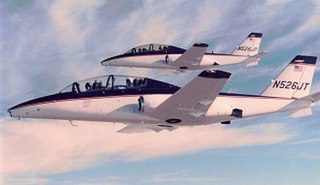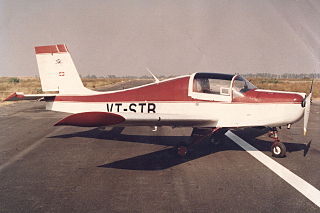
Hindustan Aeronautics Limited (HAL) is an Indian public sector aerospace and defence company, headquartered in Bengaluru (Bangalore). Established on 23 December 1940, HAL is one of the oldest and largest aerospace and defence manufacturers in the world. HAL began aircraft manufacturing as early as 1942 with licensed production of Harlow PC-5, Curtiss P-36 Hawk and Vultee A-31 Vengeance for the Indian Air Force. HAL currently has 11 dedicated Research and development (R&D) centres and 21 manufacturing divisions under 4 production units spread across India. HAL is managed by a board of directors appointed by the President of India through the Ministry of Defence, Government of India. In 2024, the company was given Maharatna status. HAL is currently involved in the designing and manufacturing of fighter jets, helicopters, jet engine and marine gas turbine engine, avionics, hardware development, spares supply, overhauling and upgrading of Indian military aircraft.

The Indian Air Force (IAF) is the air arm of the Indian Armed Forces. Its primary mission is to secure Indian airspace and to conduct aerial warfare during armed conflicts. It was officially established on 8 October 1932 as an auxiliary air force of the British Empire which honoured India's aviation service during World War II with the prefix Royal. After India gained independence from United Kingdom in 1947, the name Royal Indian Air Force was kept and served in the name of the Dominion of India. With the transition to a republic in 1950, the prefix Royal was removed.

The Pilatus PC-7 Turbo Trainer is a low-wing tandem-seat training aircraft, designed and manufactured in Switzerland by Pilatus Aircraft. The aircraft is capable of all basic training functions, including aerobatics, instrument, tactical, and night flying.

The Pilatus P-3 was a military training aircraft built by Pilatus Aircraft of Switzerland.

The Aero Boero AB-115 is an Argentine civil utility aircraft. It was developed from the AB-95-115, a refined AB-95 with a more powerful engine and improved aerodynamics. Specific differences included wheel spats, a redesigned engine cowling molded of fiberglass, and aluminum ailerons and flaps.

The HAL HJT-16 Kiran is an Indian two-seat intermediate jet-powered trainer aircraft designed and manufactured by aircraft company Hindustan Aeronautics Limited (HAL).

The PZL 130 Orlik is a Polish turboprop, single engine, two seat trainer aircraft.

The Fuji T-3 is a primary military trainer aircraft used by the Japan Air Self Defense Force, manufactured by Fuji Heavy Industries. Its first flight was in 1978. In the course of its service life, 50 units were produced. It is has been replaced by the Fuji T-7.

The Myasishchev M-101T is a Russian business class aircraft, designed by Myasishchev and built by Sokol. The aircraft was first flown on 31 March 1995.

The Gavilán 358 is a Colombian light utility transport aircraft of the 1990s. A high-winged monoplane powered by a piston engine, small numbers of Gaviláns were produced in the late 1990s/early 2000s, some serving with the Colombian Air Force.

The Fuji T-5 or KM-2Kai is a Japanese turboprop-driven primary trainer aircraft, which is a development of the earlier Fuji KM-2. The student and the instructor sit side-by-side.

The Fuji T-7 is a Japanese primary trainer aircraft built by Fuji Heavy Industries for the Japan Air Self-Defense Force. A development of Fuji's earlier T-3 trainer, it is a single-engined monoplane powered by a turboprop engine.

The Cessna 526 CitationJet was a twinjet trainer candidate for the United States Joint Primary Aircraft Training System proposed by Cessna. It was a twin-engined, tandem seat aircraft, based on the Cessna CitationJet executive aircraft. However, it was unsuccessful, with only two prototypes built.
The Hongdu N-5,, originally known as the Nanchang N-5, is a Chinese agricultural aircraft. First flown in 1989, and entering into production in 1992, the N-5 is a single-engined low-wing monoplane, and is available in versions powered by a piston engine or a turboprop.
The Indian Air Force has been undergoing a modernization program to replace and upgrade outdated equipment since the late 1990s to meet modern standards. For that reason, it has started procuring and developing aircraft, weapons, associated technologies, and infrastructures. Some of these programs date back to the late 1980s. The primary focus of current modernization and upgrades is to replace aircraft purchased from the Soviet Union that currently form the backbone of the air force.

The Bharat Swati is an Indian two-seat training monoplane designed by the Technical Centre of the Directorate General of Civil Aviation and built by Bharat Heavy Electricals Limited.

The Sherpa Aircraft Sherpa is an American five-seat utility aircraft designed and built by Sherpa Aircraft Manufacturing Inc. The aircraft is made in two variants, a piston engined K500 and a turboprop K650T. The aircraft has a fixed conventional landing gear with a tailwheel, also available with alternate large tundra tires, skis or floats.
The Sivel SD28 is an Italian two-seat aerobatic monoplane designed and built by Sivel Aeronautica. The SD28 is a low-wing monoplane with side-by-side seating for two and dual controls. The SD28 is powered by a nose-mounted Lycoming AEIO-320-D piston engine and has a fixed nosewheel landing gear.

The HAL HTT-40 is an Indian training aircraft designed and built by Hindustan Aeronautics Limited (HAL). It will replace the Indian Air Force's retired HPT-32 Deepak as a basic trainer.
















